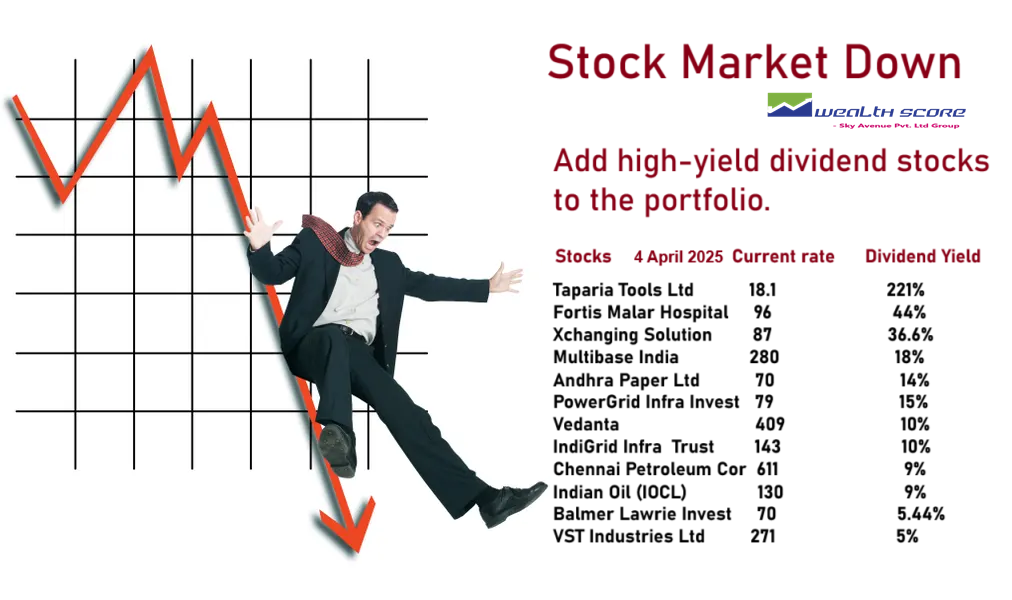Investing in dividend stocks comes with several advantages, especially for those seeking passive income and financial stability. Here’s why they can be beneficial:
Stock Market Down Add high-yield dividend stocks to the portfolio:
Benefits of high yield dividend stocks to portfolio.
Here are the key benefits of adding high-yield dividend stocks to your portfolio:
✅ 1. Regular Passive Income
You receive consistent cash payouts, usually quarterly, which can supplement income or be reinvested.
✅ 2. Compounding Returns
Reinvesting dividends (via DRIPs – Dividend Reinvestment Plans) helps compound your returns over time, especially in a long-term portfolio.
✅ 3. Lower Volatility
Dividend-paying companies, especially mature ones, are often less volatile and more stable during market downturns.
✅ 4. Hedge Against Inflation
Some companies increase dividends over time, helping your income keep pace with inflation.
✅ 5. Total Return Boost
Even if stock prices stay flat, the dividend income adds to your total return.
✅ 6. Disciplined Management
Companies that consistently pay (and raise) dividends tend to have strong financial discipline and healthier balance sheets.
✅ 7. Retirement & Income Planning
Great for retirees or conservative investors who prioritize cash flow over capital gains.
OPEN FREE DEMAT ACCOUNT CLICK HERE
what is high yield dividend stocks ?
High-yield dividend stocks are shares of companies that pay a relatively large dividend compared to their stock price. The “yield” is usually expressed as a percentage and is calculated like this:
🧮 Dividend Yield Formula
Dividend Yield=Annual Dividend per ShareShare Price×100\text{Dividend Yield} = \frac{\text{Annual Dividend per Share}}{\text{Share Price}} \times 100Dividend Yield=Share PriceAnnual Dividend per Share×100
📈 Example:
If a company pays $4 per year in dividends and its stock price is $100:
4100×100=4% dividend yield\frac{4}{100} \times 100 = 4\% \text{ dividend yield}1004×100=4% dividend yield
💰 What Counts as “High-Yield”?
-
Typically, a dividend yield above 4-5% is considered high.
-
Too high (e.g. 10%+) can be risky — it may mean the stock price is dropping or the dividend is unsustainable.
🏦 Common Sectors with High-Yield Stocks:
-
Real Estate Investment Trusts (REITs)
-
Utilities
-
Energy (especially pipeline companies)
-
Telecoms
-
Business Development Companies (BDCs)
Would you like a list of current high-yield stocks with solid fundamentals?
✅ Things to Check Before Investing in Dividend Stocks:
-
Dividend Yield – A high yield is attractive, but too high (above 8-10%) can be risky.
-
Payout Ratio – Ideally below 60-70%. A very high ratio may indicate an unsustainable dividend.
-
Dividend Growth – Look for companies that consistently increase dividends over time.
-
Earnings Stability – Check financial health, profitability, and revenue trends.
-
Debt Levels – Avoid companies with excessive debt that might struggle to maintain dividends.
-
Industry Stability – Focus on recession-resistant sectors like consumer staples, utilities, and healthcare.
-
Tax Efficiency – Dividend taxes can affect returns; consider tax-advantaged accounts if possible.
Would you like suggestions on high-quality dividend stocks? Also, what is your risk tolerance and investment horizon?



